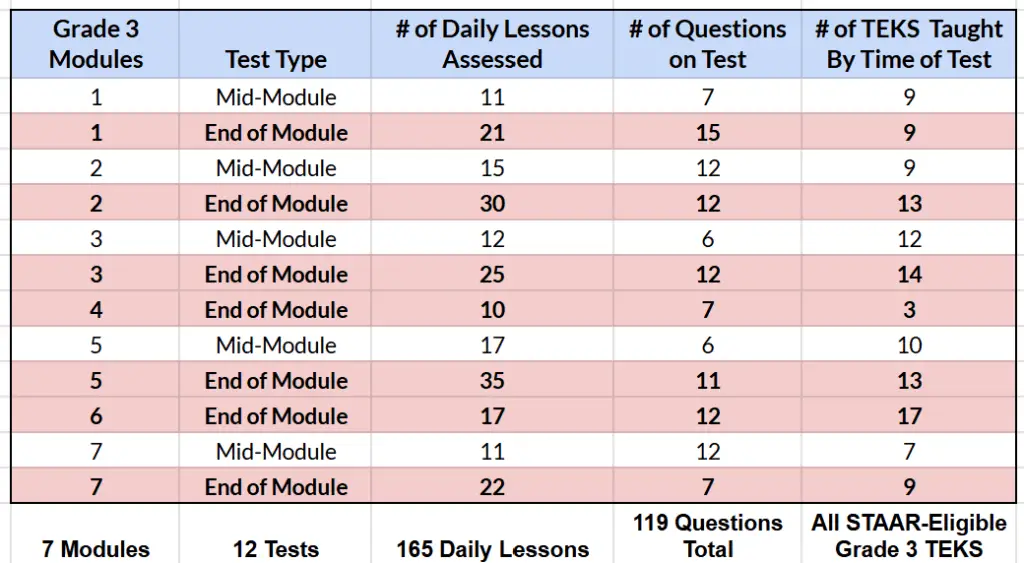Progress Monitoring with Bluebonnet Learning Curriculum is Tough for Districts and Teachers

It’s hard to do progress monitoring with Bluebonnet Learning curriculum materials. Though we’re well into the 21st Century, Bluebonnet Learning curriculum comes as printed workbooks and printed teacher guides. Classroom teachers have to collect and record progress monitoring data by hand. Collecting and grading student workbooks in between module tests is what the State of Texas envisions for educators using Bluebonnet Learning curriculums for RLA and Math. Here at Classwork.com, we offer a better way to progress monitor when using Bluebonnet Learning Math.
Effective progress monitoring is the backbone of high‑quality math instruction in Texas. When done right, it gives teachers the real-time insight they need to guide instruction, target interventions, and ensure students truly master each part of the TEKS taught before moving on. Without it, we’re left guessing—and so are our students.
Unfortunately, Bluebonnet Math—while sterling in its instructional design—creates what many educators are calling a “digital data desert.” Its form and structure limits opportunities for teachers and campus leaders to rapidly gather actionable data and respond quickly when students struggle. Let’s take a look at what progress monitoring techniques are used in math classrooms today, and how the Bluebonnet Learning curriculum falls short.
Best Practices for Progress Monitoring
For well over a decade, Texas educators have embraced digital progress monitoring strategies that usually incorporate some of all of these widely acknowledged strategies:
1. Frequent, Standards-Aligned Assessments
To truly understand where students stand, you need frequent touchpoints aligned directly to what’s being taught.
- Daily formative checks: Short (5–10 minute) quizzes or exit tickets focused on that day’s TEKS objective. These should be 3–6 questions long and include STAAR-like formats.
- Weekly topic tests: Longer assessments (12–18 questions) that cover multiple TEKS within a topic. These should reflect both readiness and supporting standards.
2. Instant, Auto-Graded Feedback
Waiting days for assessment results puts teachers at a disadvantage. Immediate results are essential.
- Automated scoring: Frees up teacher time and gives fast insight.
- Timely turnaround: Getting results in minutes allows teachers to adjust instruction before misconceptions set in.
3. Centralized, Actionable Reporting
Data should work for teachers—not the other way around. The best systems make it easy to see where help is needed.
- Multi-level dashboards: Offer visibility at the student, class, campus, and district level.
- TEKS drill-downs: Help pinpoint exactly which skills need reteaching or intervention.
4. Alignment to STAAR Formats
Familiarity breeds confidence—and reduces anxiety—when it comes to state testing.
- Item variety: Assessments should include multiple choice, multi-select, inline choice and other technology-enhanced items.
- Consistent exposure: Routine practice with these formats builds confidence and skill.
5. Integration with Daily Instruction
Progress monitoring shouldn’t feel like extra work. It should be baked into the instructional routine.
- Seamless workflow: Embedding checks into lesson plans saves planning time.
- Rubric-based observation tools: Allow teachers to assess process standards during hands-on or collaborative learning.
6. Data-Driven Intervention Cycle
Once you have the data, you need a plan. Best practice calls for immediate, targeted support.
- Remediation: Small-group or digital interventions tied to assessment results.
- Progress tracking: Continuous monitoring to adjust support and ensure growth.
Bluebonnet Learning / Eureka Math / Carnegie Learning Math is a Digital Data Desert
Despite its widely acclaimed instructional strength, Bluebonnet Math does not digitally support the kind of robust, responsive progress monitoring that Texas educators are used to.
In fact, Bluebonnet Learning Math’s current form and structure creates a serious gap between instruction and actionable data.
That is, unless teachers spend additional hours each day collecting and grading their students’ printed workbooks. But even then, there would still be problems. Here’s why.

❌ Sparse Assessments
Bluebonnet’s assessment model simply doesn’t provide enough checkpoints.
- Too few assessments: Only 10–14 module or topic assessments per year.
- No STAAR alignment: Students miss critical exposure to state test item types.
❌ Manual, Time-Consuming Data Collection
There’s no automation built into Bluebonnet Learning materials—putting extra strain on teachers.
- Grading by hand: Teachers must manually score student workbook pages.
- No consistency: Differences in grading and reporting across classrooms make it hard to trust or compare data.
❌ Delayed Feedback & Intervention
The timing of assessments makes it nearly impossible to respond quickly when students struggle.
- Infrequent checkpoints: Average time between tests ranges from 12.5 to 15 days across elementary grades.
- Too late to intervene: By the time you realize a student needs additional help, the class has already moved on.
❌ Insufficient TEKS Coverage
Not every TEKS is covered with sufficient depth—or at all—within Bluebonnet’s assessments.
- Shallow testing: Short module tests don’t assess every skill being taught.
- No embedded checks: Teachers can’t confirm mastery before advancing to new content.
❌ No Built-In STAAR Prep
Bluebonnet Learning’s Math curriculum is dense; the necessary pacing leaves little room in the calendar for purposeful test preparation.
- Tight schedule: With 150–165 instructional days, there’s almost no flex time.
- End-of-year crunch: STAAR review becomes a frantic scramble instead of a steady build.
❌ Fragmented Data for Stakeholders
A limited number of assessments means there’s not much to share or act on.
- Minimal data points: Make for vague or generalized parent-teacher conversations.
- No dashboards: District and campus leaders are left without tools for proactive planning.
- Nothing Much to Show: When any stakeholder inquires
Bridging the Gap with Classwork.com’s Texas OER Edition
Thankfully, there’s a way to close this gap without abandoning Bluebonnet. Classwork.com’s Texas OER Edition is purpose-built to bring best-practice progress monitoring into Bluebonnet Math classrooms—without overburdening teachers or sacrificing instructional integrity.
By embedding daily checks, automated feedback, and centralized reporting directly into the teaching workflow, Classwork.com turns Bluebonnet Math into a system that actually works for teachers, students, and leaders.
A Digital Data Oasis That Enhances Bluebonnet Learning Math

When schools use Classwork.com alongside Bluebonnet, they gain access to a robust set of tools built specifically for Texas classrooms:
- Daily Lesson Checks (Grades 3–8): 6–12 STAAR-style questions that are auto-graded and aligned to TEKS.
- Topic & Module Tests: 12–40 question assessments tailored to Texas standards can be made using TEKS Star item bank aligned to Bluebonnet.
- Instant Reporting: Real-time dashboards at the student, class, campus, and district level.
- Observation Forms: Built-in tools for capturing TEKS process skills during hands-on activities.
- Digital Delivery of Bluebonnet Assessments: All existing Bluebonnet tests are digitized and auto-graded—no more paper shuffling or manual entry.
Districts Get An Immediate Return on Investment
For just $3.99 per student per year, Classwork.com’s Texas Edition and OER Companion assessment items bring modern progress monitoring into any Texas math classroom—and the return on investment is immediate- happier teachers and smarter students!
Classwork.com with Our Texas OER Edition
- Qualifies for IMTA funding
- Reduces teacher grading time by 80%
- Cuts remediation needs by catching gaps early
- Boosts STAAR performance through regular, meaningful practice
Conclusion
Progress monitoring isn’t optional—it’s essential. It’s how we know what to teach, when to intervene, and whether our students are truly mastering the TEKS. While Bluebonnet Math offers a strong foundation in content and pedagogy, it falls short where it matters most: data. Without frequent, aligned, and actionable assessment, teachers are left guessing and students miss out on the timely support they need.
Classwork.com’s Texas OER Companion brings clarity, structure, and responsiveness to the classroom. It doesn’t replace Bluebonnet—it enhances it. With items for daily assessments, automated feedback, and real-time data, it empowers educators to teach smarter, intervene sooner, and help every student succeed.
STAAR® and BLUEBONNET LEARNING™ are trademarks owned by the Texas Education Agency and the appearance of those trademarks on this website implies no association. Classwork.com and its goods and services are not sponsored by, affiliated with, or approved by the Texas Education Agency.
For more information on the Bluebonnet Learning Curriculum,
please visit the Texas Education Agency’s official page.
Legal Disclaimer
Classwork.com is a digital platform provider that facilitates the interactive delivery, approval, and reporting of instructional materials, including state-adopted High-Quality Instructional Materials (HQIM) such as the Bluebonnet Learning (BBL) curriculum.
Classwork.com does not own, modify, or sell the Bluebonnet Learning curriculum or any other State of Texas Open Educational Resource (OER) materials. All BBL content remains under the State of Texas OER license, and its use within the Classwork.com platform is subject to district compliance with applicable licensing requirements.
Intellectual Property & Proprietary Rights
Classwork.com’s software, interactive overlays, item banks and activities, AI and auto-scoring technology, approval workflows, and reporting tools are proprietary intellectual property, protected under U.S. copyright law (17 U.S.C. § 102), trade secret protections, and the Digital Millennium Copyright Act (DMCA, 17 U.S.C. § 512). The use of these features within the Classwork.com platform is governed by our Terms of Service, and no aspect of our proprietary technology may be copied, distributed, or reverse-engineered without explicit authorization.
DMCA Compliance & Safe Harbor Protection
Classwork.com acts as a service provider under the DMCA and is not responsible for district or teacher-created content uploaded to the platform. If you believe that any content hosted within Classwork.com violates copyright or licensing agreements, please submit a formal DMCA takedown request.
By using Classwork.com, users acknowledge that:
– All instructional materials remain under the control of the respective copyright or OER license holders.
– Classwork.com’s role is to provide a technology infrastructure for digital instructional material delivery, not to modify or resell OER curriculum content.
– Districts are responsible for ensuring their use of OER materials complies with Texas Education Agency (TEA) guidelines and licensing terms.
For more information, please review our Terms of Service, Privacy Policy, and DMCA Compliance Procedures accessed via the footer on this page.

